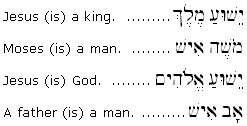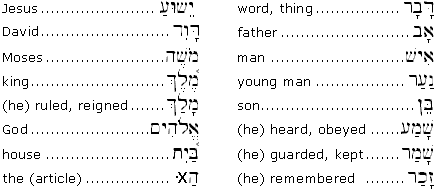|
Hebrew Masculine Singular Nouns
In Hebrew, nouns have gender: they can be masculine or feminine. Nouns also have number: they can refer to one thing (singular) or more than one thing (plural). In the list above, all the nouns are masculine singular (except for the word elohim, which is masculine plural in form but singular in meaning).
In this section of Unit Four, we will consider masculine singular nouns.
Hebrew Noun Sentences
A simple sentence in Hebrew can be constructed by simply joining two nouns together. For example,

These are complete sentences. In English, we supply the "copula" verb form ("is") to aid us in our translation, but in Hebrew, no such verb is required.
Notice also that there is no indefinite article in Hebrew. For example, the word av means "a father" (or just "father", depending on the context). Proper nouns (i.e., names of persons or titles of things, such as Jesus or Jerusalem) are considered definite by nature (that is, we do not say "A Jesus" but rather "(the) Jesus").
Introduction to the Verb
A verb is an "action" word that describes the action of a sentence. In the vocabulary list above, I have included a few common Hebrew verbs so that we could practice simple sentences using a verb. In Hebrew, a complete sentence can also be formed by using a noun and a verb together:

Notice that the second sentence reverses the word order of the subject (Jesus) and the verb (ruled). In Biblical Hebrew, the verb often appears before the subject term.
In Hebrew, verbs also have gender and number, and every verb must agree with its subject in gender and number. Therefore, masculine singular nouns must take a masculine singular verb form. The vowel pattern for the three letter shoresh (root) of a (Qal perfect) verb in the third person masculine singular is:

Notice the vowel marks under the root letters of the verb (denoted with XXX in the pattern). This pattern is the basic vocalization for the masculine verbs in the Qal perfect. This form of the verb (3ms Qal perfect) is also the lexical form of the verb (that is the form you look up in a Hebrew dictionary):
If you are new to Hebrew, do not be overly concerned about this information at this time. Just remember that verbs have specific vowel patterns to agree with the gender and number of the subject (if you can understand how the four verbs in the vocabulary list all use this vowel pattern, mazel tov!, you are beginning to understand some Hebrew grammar!).
Introduction to the Definite Article
The word "the" in Hebrew functions as a prefix to Hebrew words. That is, to make a Hebrew word definite, you add a Hey before the noun. Normally the letter following the Hey will take a dagesh forte:

For example:

Notice that when the article is added to the noun, the first letter of the noun takes the dagesh mark (in the case of davar and ben, the dagesh changes from a dagesh kal to a dagesh chazak).
Recall that a guttural letter cannot take a dagesh mark. If a noun begins with a guttural letter, then when the article is added, the patach under the Hey is changed to a different vowel. For example:

Notice that since the Aleph cannot take a dagesh, the patach under the Hey "compensates" and lengthens to a qamets.
More information about the grammar of the article is found in Section 4.6.
Proper Nouns
Proper nouns are definite by definition, and therefore do not use the definite article. The vocabulary lists three proper nouns you should memorize: Yeshua, Moshe, and David.
Section Exercises
- Memorize the section vocabulary (top of the page)
- Practice writing basic sentences using these words
- Summarize the rules of the definite article on a small flashcard
Note: In Hebrew, cities, countries, team names, etc., are generally feminine in gender, whereas the names of the months and seasons are masculine in gender.
<< Return
|






